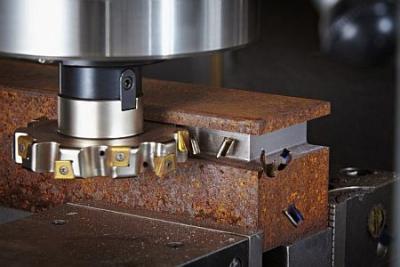
Seco Tools LLC, Troy, Mich., introduced two new insert sizes to its family of 335.25 disc milling cutters, a line that is said to provide manufacturers with high flexibility and productivity. With the additions of XNHQ inserts in 9mm and 12mm sizes, the cutter now offers a range of cutting widths from 0.531" to 1.26" (13mm to 32mm) for an even greater variety of applications.
The 335.25 disc milling cutter performs slotting, back facing, helical and circular interpolation, and plunging operations. Incorporating a unique cutter design and insert geometry with four cutting edges, the 335.25 cutter reportedly reduces cutting forces and optimizes chip flow to ensure reliable and productive machining. The line features both fixed-pocket and adjustable-width versions to accommodate all production environments.
Available in diameters ranging from 4" to 12", the 335.25 line includes 0.75" and 1" cutting widths for the fixed-pocket version, and from 0.531" to 1.26" cutting widths for the adjustable-pocket version. Inserts are offered in four sizes with corner radii from 0.016" to 0.236" (0.4mm to 6.0mm). Additionally, the range of insert grades available allows the 335.25 to be applied to all material types, and each insert reportedly reduces costs by offering four cutting edges, two left hand and two right hand.
Contact Details
Related Glossary Terms
- gang cutting ( milling)
gang cutting ( milling)
Machining with several cutters mounted on a single arbor, generally for simultaneous cutting.
- interpolation
interpolation
Process of generating a sufficient number of positioning commands for the servomotors driving the machine tool so the path of the tool closely approximates the ideal path. See CNC, computer numerical control; NC, numerical control.
- milling
milling
Machining operation in which metal or other material is removed by applying power to a rotating cutter. In vertical milling, the cutting tool is mounted vertically on the spindle. In horizontal milling, the cutting tool is mounted horizontally, either directly on the spindle or on an arbor. Horizontal milling is further broken down into conventional milling, where the cutter rotates opposite the direction of feed, or “up” into the workpiece; and climb milling, where the cutter rotates in the direction of feed, or “down” into the workpiece. Milling operations include plane or surface milling, endmilling, facemilling, angle milling, form milling and profiling.
- milling cutter
milling cutter
Loosely, any milling tool. Horizontal cutters take the form of plain milling cutters, plain spiral-tooth cutters, helical cutters, side-milling cutters, staggered-tooth side-milling cutters, facemilling cutters, angular cutters, double-angle cutters, convex and concave form-milling cutters, straddle-sprocket cutters, spur-gear cutters, corner-rounding cutters and slitting saws. Vertical cutters use shank-mounted cutting tools, including endmills, T-slot cutters, Woodruff keyseat cutters and dovetail cutters; these may also be used on horizontal mills. See milling.
- slotting
slotting
Machining, normally milling, that creates slots, grooves and similar recesses in workpieces, including T-slots and dovetails.

